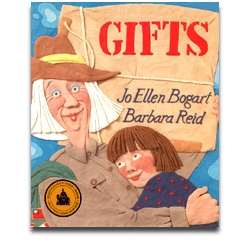 This month, every child in Grade one in Canada will receive a free book.
This month, every child in Grade one in Canada will receive a free book.
That will be every grade-one child, including those who are home-schooled, or in any school in the country, private or public, French-speaking or English-speaking.
The book giveaway is the product of a partnership between TD (the bank) and the Canadian Children’s Book Centre (CCBC).
The bank pays more than $1-million to have 500,000 books printed and sent out to grade-one students across the country. This is the program’s eleventh year.
This year the books the kids will get is Gifts (Cadeaux, translated into French), by author Jo Ellen Bogart and plasticine artist Barbara Reid.
Gifts tells the story of a grandmother who travels to different countries. She asks her granddaughter, “What would you have me bring?” with the granddaughter asking for impossible souvenirs like, “a rainbow to wear as a ring” from Hawaii and “an iceberg on a string” from the Arctic.
Grandma is incredibly inventive as she comes up with solutions for each request.
The book follows the pair as they both grow older, eventually ending with the girl now a fully grown adult with a daughter of her own.
The CCBC and TD get lots of thank-you letters after they distribute the books each year. One in particular stands out in the memory of TD’s Alan Convery.
The principal of a school in the Northwest Territories sent a letter, thanking him for the books. She said that for most of the children, this would be the first book they would own. And then she added that this would also be the only Christmas gift many of the children would receive that year, since the families in that particular community were having trouble making ends meet.
The CCBC later shipped the community another supply of different children’s books as well.
CURRICULUM CONNECTIONS
By Jonathan Tilly
Writing/Discussion Prompt
Why is it important not to take books for granted?
Brainstorm with a classmate 4 different things you could do to help make sure that children throughout Canada have books of their own.
Reading Prompt
Reread today’s article and focus on the speed of your reading. When your purpose for reading is to learn something, try to read at an even pace. Evenly paced reading helps the reader and their audience understand the information best.
Primary
Read appropriate texts at a sufficient rate and with sufficient expression to convey the sense of the text readily to the reader and an audience (OME, Reading: 3.3).
Junior & Intermediate
Read appropriate texts with expression and confidence, adjusting reading strategies and reading rate to match the form and purpose (OME, Reading: 3.3).
Grammar Feature: Idioms in context
Idioms are expressions that people say. They always have a meaning beyond the meaning of the words themselves. For example, the sentence below includes the idiom, “make ends meet.”
“And then she added that this would also be the only Christmas gift many of the children would receive that year, since the families in that particular community were having trouble making ends meet.“
By reading the whole sentence, and seeing the idiom in this context, we understand that “making ends meet” means to have difficulty living on the money one earns.
See if you can understand the idioms below by reading the whole sentence (in context).
1. She had only scratched the surface of the incredible mystery.
2. Sylvie bet the farm that her dog would win the race.
3. Adam fixed everything. He really was a Jack-of-all-trades.
4. Roofio is such an eager beaver, he often waits at the door for the recess bell.
5. Most people knew that Naomi’s baby brother was a pain in the neck.







